Sewing machines for leather: varieties, recommendations for choosing

Sewing complex and thick fabrics requires a particularly powerful and productive technique. Correctly selected needles, special feet and a wide range of functions - that's what you need for sewing drape, denim and other particularly heavy fabrics. Sewing machines for leather, eco-leather, leatherette should not jam the surface, moving the future product along the bed. Most often they are used by professionals in line production. Household models usually do not have an electric drive, and in general are somewhat different from those designed to work with light materials.


The choice of a manual machine for sewing leather and heavy fabrics, kolinsky, household and other types implies a thorough study of its functional equipment. Inexpensive, budget models designed for materials of low density are definitely not suitable for work. Also for working with different types of fabrics a lot of additional devices will be requiredfacilitating the achievement of the result. Let's consider in more detail what technique is needed for individual tailoring of leather goods and clothing items.



Peculiarities
How a sewing machine for leather or heavy fabrics differs from conventional models, let's figure it out. Among its main features, one can note the ability to hold and advance thick matter without crushing it. For this, there are special conveyors and legs that allow you to cope with the most difficult tasks. In addition, the machine for thick fabrics - drape, jeans, leatherette should provide good quality stitching. Professional devices for performing highly specialized tasks are usually single-needle.
For sewing in line mode, the the most powerful, productive equipment. She has a special table - a stand for work, lighting, a friction-type electric drive.
Household machines are also produced for dense fabrics. But not each of them sews fabric with a thickness of more than 5 mm.



By the type of drive, sewing machines for leather are mechanical, electromechanical, computerized - with intelligent control. For beginners, the microprocessor will be an overkill option. But for experienced craftsmen, this option will significantly expand the capabilities of the technique. A useful function will be the reinforced needle puncture, which allows you to pierce even thick skin. If a model with an electric drive is selected, it must have a power of at least 100 watts.


Advantages and disadvantages
The advantages of special machines for sewing leather and thick fabrics include:
- high productivity;
- high reliability;
- slow wear of components and assemblies;
- accurate calculation of characteristics;
- adaptability to work with materials of different density;
- the ability to create straight and curved seams.
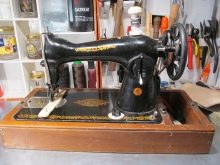


The disadvantages include significant noise during the operation of industrial machines and a rather large weight of such equipment. Household mechanical options require regular maintenance. In addition, many professional models have a highly specialized focus and cannot be used for ordinary sewing. The high price is also a significant disadvantage.
If you do not plan to launch continuous production, it is better to do with budget options that have a wide range of applications.

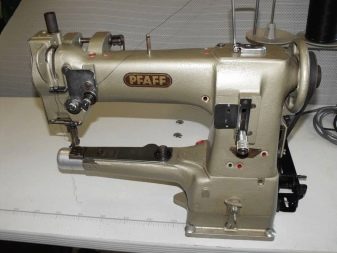
Varieties
All types of sewing machines for working with leather can be roughly divided into 2 large groups: household and industrial. The first category includes almost all handheld models with a fairly heavy base. In addition, for household sewing machines suitable for sewing leather, the following parameters are important:
- powerful drive;
- stitch length over 6 mm;
- metal, reliable assemblies;
- high height of the presser foot.
The simplest example of household hand-made equipment for sewing leather is "Podolsk". This is a class 430 machine that allows you to work with leather goods, shoes, bags, belts. But modern manufacturers offer no less functional options equipped with an electric drive.
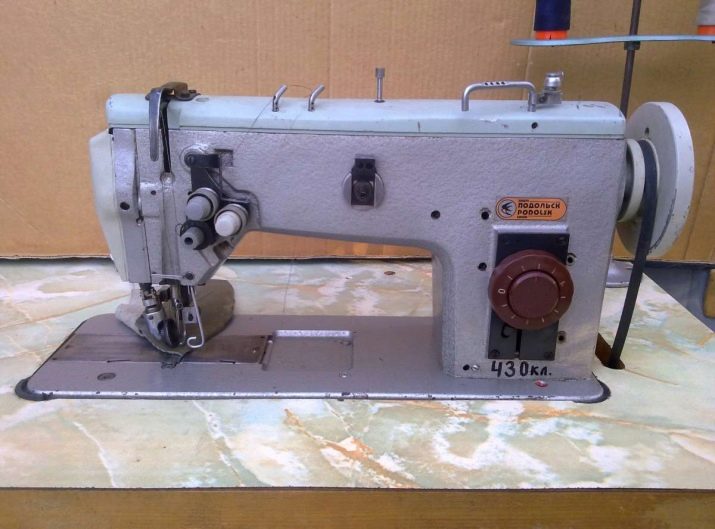
Industrial machines also differ in class. For leather, models of 22 and 1022 class are used, as well as 23 class with an electric drive, household and industrial, at 380 V.
Sleeve machine
Professional type of sewing machine, equipped with a roller element for material feeding and conveyors for synchronous operation. The sleeve platform is often included in classic household models, and is hidden in a conventional bed. Industrial machines are distinguished by the fact that they can sew edges, carry out edge trimming with tape.
Among the main parameters to look for when choosing a sleeve technique are the length of the sleeve used to feed the bobbin and the diameter of the bobbin used here.
These machines are widely used in the field of repair and individual tailoring of shoes, but when working with bulky pieces of fabric, they are not very convenient.


Column machine
Single needle columnar sewing machines for leather are categorized professional, highly specialized equipment. In their design, a column of small diameter installed above the needle holder is used, which allows you to work with small, curly objects, shoes, suitcases and trunks of large format. Such industrial machines are not cheap, but they pay for themselves in a continuous production environment.


When sewing on a column bed, the material is put directly on it, like a cover. Such models are especially convenient for sewing complex sections, curly elements, where it is important to control the quality of the stitching. With their help, you can combine the elements and details of the product in different planes.
The rotating platform and small column diameter make such a machine convenient for working with any bulky products. It surpasses the sleeve options in functionality and is necessary for sewing bags, wallets, gloves. In such a model there must be a horizontal rotary shuttle, roller feed of matter, double or triple conveyor, automatic lubrication system.
It should be noted that the lower thread feeder in such models is located inside the column.

Components
What elements and components are needed to work effectively with leather or other thick, dense materials? Among the must-have accessories, you can definitely note special feet, supplemented with rollers or rollers to avoid hitching and damage. To facilitate the advancement of the material, it is sometimes additionally used cover in the form of a thin strip of paper, which can then be easily removed.
The best material for non-roller feet with a walking design can be considered Teflon or PTFE.

The needle number and shape also matter. It uses strong steel to cope with the ultra-high resistance of the material. When sewing leather, the needle does not pierce, but cuts the surface, and should have a pointed shape. Suitable numbers range from 90/14 to 110/18. The shape of the needles are:
- oval (right, left, longitudinal, transverse);
- triangular;
- square (longitudinal, transverse).


When choosing threads, you should give preference to the most durable options from a thick multi-layer nylon. The thickness is determined based on the characteristics of the selected material. And also when working, it is recommended to use a special cutting tool - a cutter with replaceable blades, or a knife for cutting leather. It is recommended to handle allowances on the leather with rubber glue.
In addition, when working with dense materials, it is recommended to use special tools for attaching accessories.

Top Models
There are several models of sewing machines for working with leather on the modern market.
- Brother S-1000A-5. Professional sewing machine. Designed to handle medium to high density materials. In terms of characteristics, it surpasses most other models.

- Jack JK-6658. Industrial machine for creating straight stitches on tarpaulins, thick leather. The model provides a walking foot, a high strength needle. The stitch pitch is limited to 7 mm and the speed can be reached up to 2000 rpm.

- Vista SM-245... Industrial grade single-needle machine. The set includes a flat platform, a fairly powerful motor that allows you to reach a sewing speed of up to 800 rpm. Reverse sewing function is supported.
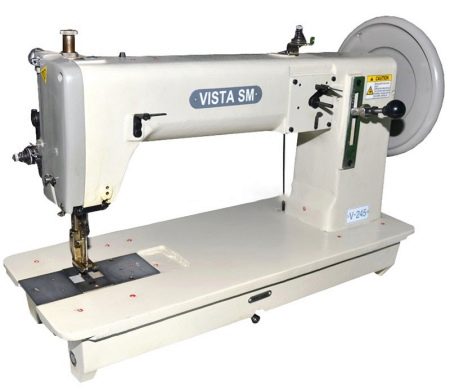
- Pfaff Ambition 1.5. A typewriter from a German brand, manufactured in Taiwan. The model is fully computer controlled. The set includes a presser foot pressure regulator, an upper conveyor, support for 195 operations, an electronic advisor, a sewing speed regulator.
The machine is quite simple to operate, does not require much experience, and can be used without a pedal.

- Toyota OEKAKI50 Renaissance. Simple and reliable Chinese assembly technique from a Japanese manufacturer. The model is equipped with a special foot that allows you to sew suede and leather, there is a needle threader, automatic buttonhole sewing, 50 work programs of varying complexity.

- Astralux 7300 SE. A household sewing machine, supports 504 operations, including sewing 13 types of buttonholes. When working with leather, you should take into account the limitation on the thickness of the material, use special paws.
A large number of functions can significantly complicate the process of working with the equipment.

- Janome 743-3. A household-grade sewing machine, the main units are made of plastic. Suitable only for sewing thin leather, leatherette, eco-leather.

A budget solution may be suitable for novice seamstresses - sold in the secondary market model "Podolsk 34" 330 class. It is no longer produced, but such a machine will be inexpensive and suitable for working with leather, raincoat fabric, jeans, drape. More modern option — "Podolsk" class 430 is widely used today in the field of sewing and repairing leather goods, including haberdashery, shoes, accessories.
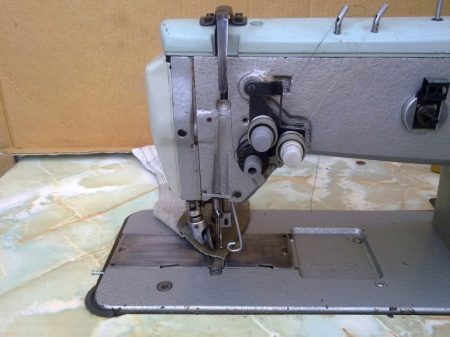
How to choose?
When choosing a sewing machine for working with leather, it is worth paying attention to a number of parameters that are of greatest importance. For example, when working with leather the function of disabling the conveyor is required. Besides, there must be a walking foot in the design, required for easier advancement of thicker material, or a pressure roller. Mandatory in industrial and domestic machines regulator of stitch parameters, standard range from 6 to 8 mm.
If special needles are not included in the package, be sure to take care of purchasing them.

The power of the machine should be higher than that of the regular household versions. The height of the presser foot when working with leather usually exceeds 8-10 mm, it is worth paying special attention to this. All components, including gears, and other rubbing parts must be metal - plastic will not withstand working loads. When choosing, you need to remember that the weight and dimensions of specialized machines for working with leather products are always higher than those for light fabrics. In most cases, you have to purchase a special stand or table to place them.
Do not assume that cheap, low-power Chinese-made machines will be able to provide sufficient performance when sewing leather or thick, high-density materials. If you plan to seriously start working with such products, you will have to spend money on purchasing reliable and functional equipment. The average cost of a household leather machine starts at 35,000 rubles.

However, for rare sewing of leather goods, even a budget model may be suitable. Janome L-394 (analogue of Janome L-22). In any case, before buying, we recommend visiting a specialized sewing machine store, where you can take a test drive on your material.

How to use?
Working with a sewing machine for natural leather requires adherence to certain recommendations. In particular, it is necessary to refrain from chipping off layers of material with pins or other sharp objects. In addition, soft leather and its substitutes can be sewn with 80 or 90 size needles for conventional sewing machines. Thicker and more multi-layered materials will have to be processed using special tools. This requires pointed needles.
When sewing leather it is important to set the stitch length at least 6 mm, in this case, the material will not crack at the puncture sites. If you have to work with suede and other fleecy materials, it is imperative to keep the seam in the direction of the pile. To avoid stretching the upper part relative to the lower one, you can use a foot with a Teflon-coated sole. In the absence of a reverse function, the ends of the stitch are tied manually, in several knots.
When choosing seams for leather, you should give preference to stitching, sewing, topstitching seams. The allowances are fixed with glue. No preliminary estimate is made.

For information on how to choose a sewing machine for leather, see the next video.








